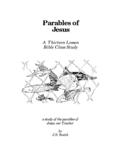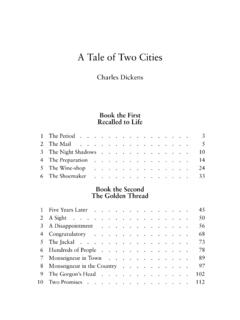Transcription of Concise History of Immunology - Columbia University
1 1A Concise History of Immunology Steven Greenberg The role of smallpox in the development of vaccination The concept of immunity from disease dates back at least to Greece in the 5th century BC. Thucydides wrote of individuals who recovered from the plague, which was raging in Athens at the time. These individuals, who had already contracted the disease, recovered and became immune or exempt. However, the earliest recognized attempt to intentionally induce immunity to an infectious disease was in the 10th century in China, where smallpox was endemic. The process of variolation involved exposing healthy people to material from the lesions caused by the disease, either by putting it under the skin, or, more often, inserting powdered scabs from smallpox pustules into the nose. Variolation was known and practiced frequently in the Ottoman Empire, where it had been introduced by Circassian traders around 1670. Unfortunately, because there was no standardization of the inoculum, the variolation occasionally resulted in death or disfigurement from smallpox, thus limiting its acceptance.
2 Variolation later became popular in England, mainly due to the efforts of Lady Mary Wortley Montague who survived smallpox but who lost a brother to it. Lady Montague was married to Lord Edward Wortley Montague, the ambassador to the Sublime Porte of the Ottomans in Istanbul. While in Istanbul, Lady Montague observed the practice of variolation. Determined not to have her family suffer as she had, she directed the surgeon of the Embassy to learn the technique and, in March 1718, to variolate her five year-old son. After her return to England, she promoted the technique, and had her surgeon variolate her four-year old daughter in the presence of the king s physician. The surgeon, Charles Maitland, was given leave to perform what came to be known as the Royal Experiment, in which he variolated six condemned prisoners who later survived. By these and other experiments, the safety of the procedure was established, and two of the king s grandchildren were variolated on April 17, 1722.
3 After this, the practice of variolation spread rapidly throughout England in the 1740s and then to the American colonies. Edward Jenner and the development of the first safe vaccine for smallpox Although Jenner is rightly celebrated for his development of cowpox as a safe vaccine for smallpox, he was not the first to make use of a relatively non-pathogenic virus to induce immunity. In 1774, Benjamin Jesty, a farmer, inoculated his wife with the vaccinia virus obtained from farmer Elford of Chittenhall, near Yetminster. In 1796, Jenner inoculated James Phipps with material obtained from a cowpox lesion that appeared on the hand of a dairymaid (Fig. 1). Six weeks later, he inoculated the experimental subject with smallpox without producing disease. Although this experiment justifiably lacked an appropriate control, further studies by Jenner established the efficacy of his vaccination procedure. For this feat, Jenner received a cash prize of 30,000 pounds and election to nearly all of the learned societies throughout Europe.
4 2 Koch, Pasteur, and the germ theory of disease In 1875, Robert Koch, a country physician with no formal scientific training, inoculated the ear of a rabbit with the blood of an animal that had died of anthrax. The rabbit died the next day. He isolated infected lymph nodes from the rabbit and was able to show that the bacteria contained within them could transfer disease to other animals. He developed and refined techniques necessary for the cultivation of bacteria, including the development of agar growth medium. He was appointed to the Institute of Hygiene in Berlin, where his ultimate goal was to identify the organism responsible for the White Death --tuberculosis. Quite independently, Louis Pasteur began his studies of the chicken cholera bacillus. In a serendipitous discovery, Pasteur inadvertently left a flask of the bacillus on the bench over the summer and inoculated 8 chickens with this old but viable stock of chicken cholera bacillus. He found that not only did the chickens not die, but they did not even appear ill!
5 Pasteur said that the virulent chicken cholera bacillus had become attenuated by sitting on the bench over the summer months. The similarity between these results and those of and Jenner using vaccinia virus was immediately apparent to him. In honor of Jenner, Pasteur called his treatment vaccination. Pasteur later worked on anthrax and rabies and developed the first viable vaccine for anthrax and rabies. Although Koch and Pasteur were contemporaries, they were intensely competitive and actually bitter enemies--of course, the outbreak of the Franco-Prussian war (1870) did nothing to cement their relationship. In a trenchant example of how not to behave toward a colleague at a scientific meeting, Koch made his way to the podium following Pasteur s lecture and said: When I saw in the program that Monsieur Pasteur was to speak attended the meeting eagerly, hoping to learn something must confess that I have been disappointed, as there is nothing new in the speech which Monsieur Pasteur has just Although many consider Pasteur the father of Immunology (?)
6 Parent of Immunology ) it is due to both his and Koch s efforts that firmly established the germ theory of disease. Prior to this time, although the practical benefits of variolation were apparent, there was no known biological basis for either the cause of diseases or the efficacy of vaccination. Fig. 1. Jenner s drawing of cowpox lesion from which he created his vaccine. 3 The emerging distinction between cellular and humoral immunity Metchnikoff was the first to recognize the contribution of phagocytosis to the generation of immunity. In Italy, while studying the origin of digestive organs in starfish larvae, he observed that certain cells unconnected with digestion surrounded and engulfed carmine dye particles and splinters that he had introduced into the bodies of the larvae. He called these cells phagocytes (from Greek words meaning devouring cells ). Working first at the Bacteriological Institute in Odessa (1886-87), and later at the Pasteur Institute in Paris, Metchnikoff established that the phagocyte is the first line of defense against infection.
7 He became a leading proponent of the Cellularists who believed that phagocytes, rather than antibodies, played the leading role in immunity. Supporters of the alternative theory, the Humoralists, believed that a soluble substance in the body was mainly responsible for mediating immunity. Building upon the demonstration by Von Behring and Kitasato of the transfer of immunity against Diphtheria by a soluble anti-toxin in the blood, Paul Ehrlich predicted the existence of immune bodies (antibodies) and side-chains from which they arise (receptors). Ehrlich suggested that antigens interact with receptors borne by cells, resulting in the secretion of excess receptors (antibodies). Ehrlich surmised that erythrocytes would not have this capacity and speculated that this immune function might be a specialized characteristic or haemopoietic tissue (Fig. 2). Ehrlich was probably the first scientist to introduce the concept of immunological self/not-self discrimination, a mechanism.
8 Which prevents the production within the organism of amboceptors (antibodies) directed against its own tissues. In this horror autoxicus, we are dealing with a well-adapted regulatory contrivance. Summary of the state of Immunology at the end of the 19th century By the turn of the century, several paradigms had been established that laid the groundwork for future studies in Immunology . The first was based on the germ theory of disease (Koch and Pasteur) which held that disease was caused by bacteria. The second paradigm was that Fig. 2. Ehrlich s drawing of a haemopoietic cell bearing side chains (receptors) and releasing immune bodies (antibodies). 4immunity to infection could be transferred by a soluble substance in the serum (Von Behring and Kitasato) elaborated by specialized cells of the immune system (Ehrlich) and that the regulation of this process (generation of antibodies) was important to minimize the possibility of developing an immune response against self (Ehrlich).
9 Finally, the immune system responds to bacterial pathogens by the recruitment of phagocytes, which recognize, engulf, and destroy the microbes via phagocytosis (Metchnikoff). The first Nobel prize in Physiology or Medicine was awarded to von Behring for his work on serum therapy, especially its application against diphtheria, by which he has opened a new road in the domain of medical science and thereby placed in the hands of the physician a victorious weapon against illness and deaths. Metchnikoff and Ehrlich shared the Nobel prize in 1908 in recognition of their work on immunity. The early dominance of humoral theories of immunity and later emergence of theories of cellular immunity Between the years 1900 and 1942 the Humoralists played a dominant role in Immunology . There were several reasons for this, not the least of which was the demonstration that transfer of immunity could be accomplished by soluble factors later shown to be antibodies (Von Behring, Roux) and complement (Bordet).
10 Furthermore, much of the phenomenology of immunopathology ( , the Arthus reaction, anaphylaxis, serum sickness, hemolytic anemia) could be associated with the activity of specific circulating antibodies. Indeed, no other basis for immunological specificity was recognized. The case for antibodies as the fundamental unit of immunity was strengthened by the ascendancy of immunochemistry, a term coined by Arrhenius. The chemistry of antigen-antibody reactions was uncovered largely by the development of the quantitative precipitin reactions by Michael Heidelberger and Elvin Kabat (a former Professor at The College of Physicians & Surgeons). These studies paved the way for a more fundamental understanding of the immunoglobulin molecule, which culminated in the elucidation of antibody structure by Rodney Porter and Gerard Edelman in the late 1950s. However, several experimental observations challenged the prevailing view that antibodies alone served to confer specific immunity. Delayed type hypersensitivity ( , tuberculin reactivity), first recognized by Koch in 1883, and allograft rejection (Medawar, 1944) appeared to be unrelated to the presence of circulating antibodies.


















